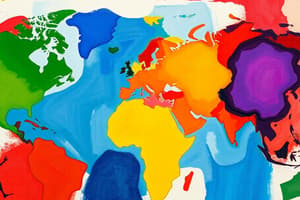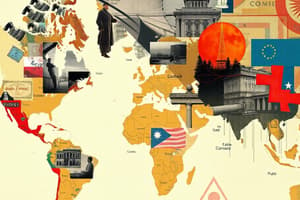Podcast
Questions and Answers
What is the likely professional role of M. in the context of 'Communication interculturelle'?
What is the likely professional role of M. in the context of 'Communication interculturelle'?
- A researcher analyzing intercultural communication data.
- An instructor or teacher of intercultural communication. (correct)
- A student studying intercultural communication.
- A translator specializing in intercultural texts.
If 'Communication interculturelle' is a course, what might be a central theme explored within it?
If 'Communication interculturelle' is a course, what might be a central theme explored within it?
- Strategies for improving personal communication skills.
- Analysis of international trade agreements.
- Understanding and navigating cultural differences in communication. (correct)
- The history and evolution of global languages.
In an educational setting focusing on 'Communication interculturelle', what type of assignment might students typically undertake?
In an educational setting focusing on 'Communication interculturelle', what type of assignment might students typically undertake?
- Analyzing the plot structure of a foreign film.
- Writing a business plan for an international corporation.
- Developing a marketing campaign for a new technological product.
- Conducting interviews with individuals from diverse cultural backgrounds about communication styles. (correct)
How might understanding 'Communication interculturelle' benefit professionals working in international business?
How might understanding 'Communication interculturelle' benefit professionals working in international business?
What is a potential challenge in 'Communication interculturelle' that M., as an instructor, might address in their teaching?
What is a potential challenge in 'Communication interculturelle' that M., as an instructor, might address in their teaching?
Which concept does Joëlle Farchy's view of cultural diversity encompass?
Which concept does Joëlle Farchy's view of cultural diversity encompass?
What is the central argument of the 'syncrétisme des identités et des cultures' thesis regarding cultural diversity?
What is the central argument of the 'syncrétisme des identités et des cultures' thesis regarding cultural diversity?
How does the 'éclectisme des identités et des cultures' thesis approach cultural diversity?
How does the 'éclectisme des identités et des cultures' thesis approach cultural diversity?
According to Samuel Huntington's 'Clash of Civilizations' theory, what is the primary source of conflict in the modern world?
According to Samuel Huntington's 'Clash of Civilizations' theory, what is the primary source of conflict in the modern world?
In Huntington's view, what is the nature of the relationship between civilizations?
In Huntington's view, what is the nature of the relationship between civilizations?
How does UNESCO define cultural diversity?
How does UNESCO define cultural diversity?
Which of the following best describes the potential outcome of civilizational conflicts, according to the theory of the 'clash of civilizations'?
Which of the following best describes the potential outcome of civilizational conflicts, according to the theory of the 'clash of civilizations'?
What concept, discussed by Tristan Mattelart, is identified as a potential promoter of cultural diversity?
What concept, discussed by Tristan Mattelart, is identified as a potential promoter of cultural diversity?
Which factor significantly contributed to the rise of intercultural communication studies, particularly in the context of globalization?
Which factor significantly contributed to the rise of intercultural communication studies, particularly in the context of globalization?
According to the material, what is insufficient for complete intercultural understanding?
According to the material, what is insufficient for complete intercultural understanding?
How are stereotypes described in the context of intercultural communication?
How are stereotypes described in the context of intercultural communication?
What is the core belief of the culturalist theory as presented in the material?
What is the core belief of the culturalist theory as presented in the material?
Which of the following is a critique of the culturalist theory?
Which of the following is a critique of the culturalist theory?
How does the interactionist theory view the individual in intercultural interactions?
How does the interactionist theory view the individual in intercultural interactions?
According to the material, what is 'culture' considered to be from an interactionist perspective?
According to the material, what is 'culture' considered to be from an interactionist perspective?
Who are the key figures associated with the development of interactionist theory in intercultural communication?
Who are the key figures associated with the development of interactionist theory in intercultural communication?
When was the notion of 'cultural diversity' adopted by UNESCO, as mentioned in the material?
When was the notion of 'cultural diversity' adopted by UNESCO, as mentioned in the material?
Which perspective would view intercultural communication as shaped by the active participation of individuals interpreting cultural codes during socialisation?
Which perspective would view intercultural communication as shaped by the active participation of individuals interpreting cultural codes during socialisation?
Flashcards
Intercultural Communication
Intercultural Communication
Interaction and exchange between people from different cultural backgrounds.
Culture
Culture
The set of shared values, beliefs, attitudes, and behaviors of a group.
Ethnocentrism
Ethnocentrism
Judging other cultures based on the standards of one's own culture.
Cultural Sensitivity
Cultural Sensitivity
Signup and view all the flashcards
Stereotype
Stereotype
Signup and view all the flashcards
Globalization's Impact on Intercultural Communication
Globalization's Impact on Intercultural Communication
Signup and view all the flashcards
Language as an Obstacle
Language as an Obstacle
Signup and view all the flashcards
Culturalism
Culturalism
Signup and view all the flashcards
Culturalism's Core Idea
Culturalism's Core Idea
Signup and view all the flashcards
Criticisms of Culturalism
Criticisms of Culturalism
Signup and view all the flashcards
Interactionist Theory
Interactionist Theory
Signup and view all the flashcards
Culture in Interactionism
Culture in Interactionism
Signup and view all the flashcards
Cultural Diversity
Cultural Diversity
Signup and view all the flashcards
UNESCO's Role in Cultural Diversity
UNESCO's Role in Cultural Diversity
Signup and view all the flashcards
Cultural Diversity (UNESCO)
Cultural Diversity (UNESCO)
Signup and view all the flashcards
Cultural Diversity (Farchy)
Cultural Diversity (Farchy)
Signup and view all the flashcards
Syncrétisme of Cultures
Syncrétisme of Cultures
Signup and view all the flashcards
Eclecticism of Cultures
Eclecticism of Cultures
Signup and view all the flashcards
Dialogue of Cultures
Dialogue of Cultures
Signup and view all the flashcards
Huntington's Civilizations
Huntington's Civilizations
Signup and view all the flashcards
Clash of Civilizations Thesis
Clash of Civilizations Thesis
Signup and view all the flashcards
Civilizational Conflict
Civilizational Conflict
Signup and view all the flashcards
Study Notes
- The lecture covers intercultural communication in Licence 1 INFO COM, 2024-2025.
- The instructor is M. Ngono.
- The lecture is Séance 3.
Emergence Context of Intercultural Communication
- Several factors contribute to studies in intercultural communication.
- Intercultural communication is increasingly common due to globalization.
- The "5th globalization" (El Mouhoub Mouhoud, 2017) discusses the immigration of workers from one country or continent to another.
Obstacles to Intercultural Communication
- Intercultural communication faces several obstacles.
- Language proficiency alone isn't enough to understand others.
- Understanding communication codes and cultural specificities is essential.
- Stereotypes are visions or ideas repeated about others without critical examination.
- Stereotypes are representations and habits leading to judgments not based in reality.
Theories of Interculturality
- The lecture plan includes the following theories:
- Culturalist theory or culturalism
- Interactionist theory
- Theory of cultural diversity
- Theory of the "clash of civilizations"
Culturalist Theory or Culturalism
- Authored by Ruth Benedict, an American anthropologist.
- Benedict's work is "Patterns of Culture."
- Culture understood as rigid shapes the personality of individuals.
- Culturalism places culture as the primary explanation for differences between human groups and their social behaviors.
- Culture has a strong influence on individual behaviors.
Critique of Culturalist Theory
- The theory is criticized for being simplistic and reductionist, leading to generalizations.
- It neglects individual particularities.
- It is limiting and prescriptive, stripping individuals of their unique richness.
Interactionist Theory
- Developed by Jean-René Ladmiral (French philosopher) and Edmond Marc Lipiansky (French psychologist).
- The theory was developed in 1989.
- Their work is titled "La communication interculturelle" (Intercultural Communication).
- Interactionism views the individual as an active actor interacting with social elements, not a passive agent.
- Individuals are seen as active and capable of interpreting cultural elements and codes for socialization.
- Culture is the product of co-construction through interactions between individuals and other members of society.
Theory of Cultural Diversity
- Cultural diversity as a political concept was adopted by UNESCO in 2001.
- UNESCO has a Convention on the Protection and Promotion of Cultural Expressions (2001, 2005).
- In Communication and Information Sciences (SIC), this concept is discussed by Françoise Benhamou, Joëlle Farchy, Tristan Mattelart, Armand Mattelart, etc.
- Cultural diversity is a polysemous and ambiguous concept.
- UNESCO (2001, 2005) defines cultural diversity as the variety of ways cultures express themselves.
- Joëlle Farchy (2013) defines cultural diversity as the coexistence of different communities within a society and respect for cultures.
Confronting Thesis of Cultural Diversity
- Two thesis confronts the topic of cultural diversity:
- Syncratism
- Eclecticism
- The syncratism says contemporary world is interconnection.
- There is no authentic culture.
Thesis of Syncratism
- Cultures are results of mixers and can only be hybrid, or syncritic (James Clifford, 1996)
- The eclecticism means to select elements from different cultures and appreciate them.
- Dialogue of cultures (Mattelart, 2007).
- Dialogue of cultures is a susceptible of favouring cultural diversity.
Theory of the "Clash of Civilizations"
- Founded by Samuel Huntington, an American political science professor.
- One of his major works is "The Clash of Civilizations."
- The central thesis describes a world divided into eight civilizations.
- Key factors will be culture and cultural identity.
- Cohesion, disintegration, and conflict make up new world.
- Civilizations are in opposition and confrontation.
- They do not dialogue, and are often in conflict.
- Civilizational conficts can lead to state conflicts.
Studying That Suits You
Use AI to generate personalized quizzes and flashcards to suit your learning preferences.




